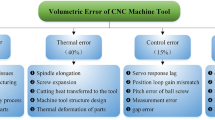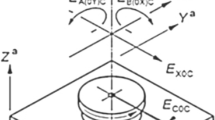Abstract
In this work, a methodology for the estimation of the geometrical accuracy of five-axis milling centres is developed by using the well-known formulation proposed by Denavit and Hartenberg. Five-axis milling centres are kinematically much more complex than three-axis centres and, therefore, the consequences of parallelism and squareness errors between elements and joints are not as easily calculated. In the method presented here, assembly errors are introduced as additional geometric parameters in the element transformation matrices, resulting in the real transformation matrix for a real and, therefore, imperfect five-axis milling machine. This matrix defines the real position of the tool in the absolute reference system. Three types of machine structures have been studied, which are the most commonly built, assembled and sold: gantry with a two-rotary-axes head, transverse column with a two-rotary-axes tilting table and, finally, a machine with a swivelling spindle and rotating plate. Each of the elemental errors is described and the way to introduce them into the Denavit and Hartenberg matrices is proposed. Some of the errors can be measured using the ISO standard procedures but others must be measured using special experiments, which are described in Sect. 4 of this paper. Finally, a real application of the proposed methodology to improve the precision of a multi-axis drilling operation is explained.
Similar content being viewed by others
References
Rahman M (2004) Modeling and measurement of multi-axis machine tools to improve positioning accuracy in a software way. PhD thesis, University of Oulu, Finland
Ramesh R, Mannan MA, Poo AN (2000) Error compensation in machine tools—a review. Part I: geometric, cutting-force induced and fixture-dependent errors. Int J Mach Tools Manuf 40(9):1235–1256
Slocum AH (1992) Precision machine design. Prentice Hall, Englewood Cliffs, New Jersey
Tsutsumi M, Saito A (2004) Identification of angular and positional deviations inherent to 5-axis machining centers with a tilting-rotary table by simultaneous four-axis control movements. Int J Mach Tools Manuf 44(12–13):1333–1342
Elbestawit MA, Srivasta AK, Veldhuis SC (1995) Modelling geometric and thermal errors in a five-axis CNC machine tool. Int J Mach Tools Manuf 35(9):1321–1337
Nawara L, Kowalski J, Sladek J (1989) The influence of kinematic errors on the profile shapes by means of CMM. CIRP Annals 38(1):511–516
Soons JA, Theuws FC, Schllekens PH (1992) Modeling the errors of multi-axis machines: a general methodology. Precis Eng 14(1):5–19
Suh S-H, Lee J-J, Kim S-K (1998) Multiaxis machining with additional-axis NC system: theory and development. Int J Adv Manuf Technol 14(12):865–875
Ferreira PM, Liu CR (1989) An analytical quadratic model for the geometric errors of a machine tool. J Manuf Syst 5(1):51–63
Mou J, Liu CR (1995) A method for enhancing the accuracy of CNC machine tools for on-machine inspection. J Manuf Syst 11(4):229–237
Sørby K (2006) Inverse kinematics of five-axis machines near singular configurations. Int J Mach Tools Manuf (in press). Available online 15 May 2006
Cho JH, Cho MW, Kim K (1994) Volumetric error analysis of a multi-axis machine tool machining a sculptured surface workpiece. Int J Prod Res 32(2):345–363
Jha BK, Kumar A (2003) Analysis of geometric errors associated with five-axis machining centre in improving the quality of cam profile. Int J Mach Tools Manuf 43(6):629–636
Lei WT, Hsu YY (2002) Accuracy test of five-axis CNC machine tool with 3D probe-ball. Part II: errors estimation. Int J Mach Tools Manuf 42(10):1163–1170
Lin PD, Ehmann KF (1993) Direct volumetric error evaluation for multi-axis machines. Int J Mach Tools Manuf 33(5):675–693
Lee R-S, She C-H (1997) Developing a postprocessor for three types of five-axis machine tools. Int J Adv Manuf Technol 13(9):658–665
Lin Y, Shen Y (2003 ) Modelling of five-axis machine tool metrology models using the matrix summation approach. Int J Adv Manuf Technol 21(4):243–248
Mahbubur RMD, Heikkala J, Lappalainen K, Karjalainen JA (1997) Positioning accuracy improvement in five-axis milling by post processing. Int J Mach Tools Manuf 37(2):223–236
Tutunea-Fatan OR, Feng H-Y (2004) Configuration analysis of five-axis machine tools using a generic kinematic model. Int J Mach Tools Manuf 44(11):1235–1243
Moon S-K, Moon Y-M, Kota S (2001) Screw theory based metrology for design and error compensation of machine tools. In: Proceedings of the ASME 2001 Design Engineering Technical Conferences (DETC 2001), Pittsburgh, Pennsylvania, September 2001
Lee E-S, Suh S-H, Shon J-W (1998) A comprehensive method for calibration of volumetric positioning accuracy of CNC-machines. Int J Adv Manuf Technol 14(1):43–49
Raksiri C, Parnichkun M (2004) Geometric and force errors compensation in a 3-axis CNC milling machine. Int J Mach Tools Manuf 44(12–13):1283–1291
Chen G, Yuan J, Ni J (2001) A displacement measurement approach for machine geometric error assessment. Int J Mach Tools Manuf 41(1):149–161
Sartori S, Zhang GX (1995) Geometric error measurement and compensation of machines. CIRP Annals 44(2):599–609
Fan K, Lin J, Lu S (1996) Measurement and compensation of thermal error on a machining center. In: Proceedings of the 4th International Conference on Automation Technology, Hsinchu, Taiwan, July 1996, pp 261–268
Salgado MA, López de Lacalle LN, Lamikiz A, Muñoa J, Sánchez J (2005) Evaluation of the stiffness chain on the deflection of end-mills under cutting forces. Int J Mach Tools Manuf 45(6):727–739
Uriarte L, Herrero A, Zatarain M, Santiso G, Lopéz de Lacalle LN, Lamikiz A, Albizuri J (2006) Error budget and stiffness chain assessment in a micromilling machine equipped with tools less than 0.3 mm in diameter. Precis Eng (in press). Available online 28 February 2006
Armarego EJA, Deshpande NP (1991) Computerized end-milling force predictions with cutting models allowing for eccentricity and cutter deflections. CIRP Annals 40(1):25–29
López de Lacalle LN, Lamikiz A, Sánchez JA, Salgado MA (2004) Effects of tool deflection in the high-speed milling of inclined surfaces. Int J Adv Manuf Technol 24(9–10):621–631
Kim GM, Kim BH, Chu CN (2003) Estimation of cutter deflection and form error in ball-end milling process. Int J Mach Tools Manuf 43(9):917–924
López de Lacalle LN, Lamikiz A, Sánchez JA, Salgado MA (2006) Toolpath selection based on the minimum deflection cutting forces in the programming of complex surfaces milling. Int J Mach Tools Manuf (in press). Corrected proof, available online 11 May 2006
Ikua BW, Tanaka H, Obata F, Sakamoto S (2001) Prediction of cutting forces and machining error in ball end milling of curved surfaces—I theoretical analysis. Precis Eng 25(4):266–273
Donaldson RR (1980) Error budgets. In: Hocken RJ (ed) Technology of machine tools, vol 5: machine tool accuracy, Chap 9: machine tool task force, Lawrence Livermore, Berkeley, California
Walter MM, Norlund B, Koning RJ, Roblee JW (2002) Error budget as a design tool for ultra-precision diamond turning machines. In: Proceedings of the ASPE’s 17th Annual Meeting, St. Louis, Missouri, October 2002
Treib T, Matthias E (1987) Error budgeting: applied to the calculation and optimization of the volumetric error field of multiaxis systems. CIRP Annals 36(1):365–368
ISO 230-1:1996 Test code for machine tools. Part 1: geometric accuracy of machines operating under no-load or quasi-static conditions
ISO 10791-2:2001 Test conditions for machining centres. Part 2: geometric tests for machines with vertical spindle or universal heads with vertical primary rotary axis (vertical Z-axis)
ISO 10791-1:1998 Test conditions for machining centres. Part 1: geometric tests for machines with horizontal spindle and with accessory heads (horizontal Z-axis)
Okafor AC, Ertekin YM (2000) Vertical machining center accuracy characterization using laser interferometer. Part 1. Linear positional errors. J Mater Process Technol 105(3):394–406
Zargarbashi SHH, Mayer JRR (2006) Assessment of machine tool trunnion axis motion error, using magnetic double ball bar. Int J Mach Tools Manuf 46(14):1823–1834
Author information
Authors and Affiliations
Corresponding author
Rights and permissions
About this article
Cite this article
Lamikiz, A., López de Lacalle, L.N., Ocerin, O. et al. The Denavit and Hartenberg approach applied to evaluate the consequences in the tool tip position of geometrical errors in five-axis milling centres. Int J Adv Manuf Technol 37, 122–139 (2008). https://doi.org/10.1007/s00170-007-0956-5
Received:
Accepted:
Published:
Issue Date:
DOI: https://doi.org/10.1007/s00170-007-0956-5




